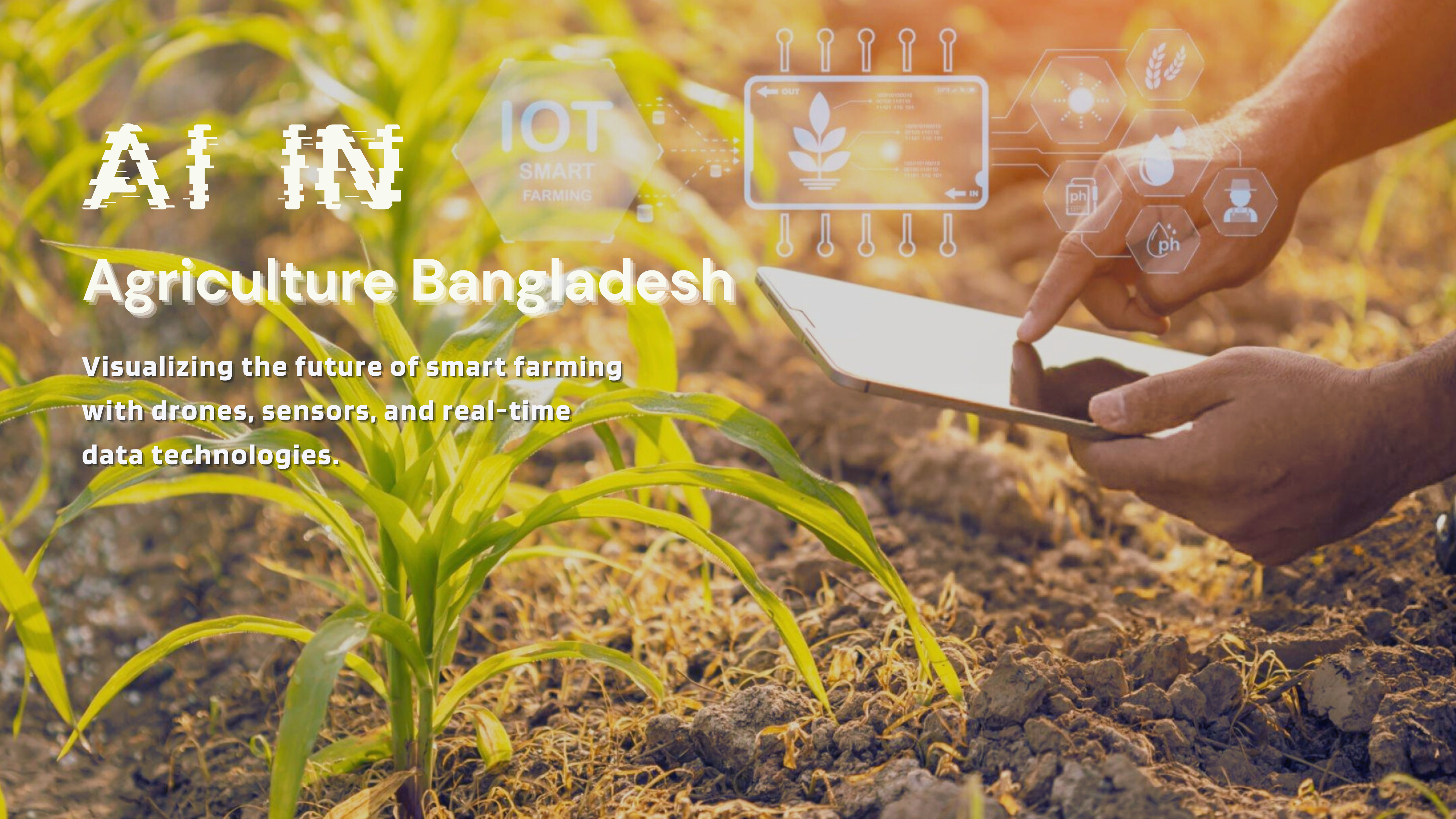
Introduction to AI in Bangladeshi Agriculture
Bangladesh, a nation heavily dependent on farming, is witnessing a rapid transformation in its agricultural landscape through technology. AI in Agriculture Bangladesh is emerging as a revolutionary force, helping farmers improve productivity, manage resources efficiently, and adapt to climate challenges with smarter, data-driven decisions.
Today, AI in Agriculture Bangladesh is not just a trend—it’s a transformation. From drones scanning crops to smart irrigation systems that reduce water waste, AI technologies are making farming smarter, faster, and more efficient.
-
According to the Food and Agriculture Organization (FAO), digital agriculture and AI play a vital role in building sustainable food systems.
Why Agriculture Still Matters in Bangladesh
Role of Agriculture in GDP and Employment
Agriculture contributes approximately 14% to Bangladesh’s GDP and employs nearly 41% of the labor force. It plays a vital role in poverty reduction, food security, and national development.
Key Challenges in the Current Agricultural System
Despite these contributions, the sector faces numerous challenges:
-
Erratic climate patterns and frequent floods
-
Soil degradation and water scarcity
-
Limited access to market intelligence
-
Poor use of data in decision-making
-
Outdated tools and farming practices
How AI in Agriculture Bangladesh Is Transforming Farming
Let’s explore how AI in Agriculture Bangladesh is tackling age-old problems with futuristic solutions.
AI for Soil Health Monitoring
AI-powered soil testing devices combine sensor technology with machine learning algorithms to analyze nutrient levels, detect deficiencies, and recommend tailored fertilizer applications. This not only improves yields but reduces costs by avoiding overuse of inputs.
-
Real-time soil moisture analytics
-
Balanced fertilization recommendations
-
Predictive irrigation to reduce water waste
AI-Powered Weed, Pest, and Disease Control
AI-driven image recognition and predictive modeling enable farmers to detect threats early and act quickly:
-
Mobile apps scan and diagnose plant diseases from images with 90 %+ accuracy
-
Smart sensors detect motion, heat, and other signs of pest activity
-
Predictive AI models alert farmers to possible outbreaks based on weather and historical data
This targeted approach reduces pesticide use by up to 40%, saving money and promoting environmental health.
Smart Irrigation in AI-Powered Agriculture in Bangladesh
With real-time data from soil and weather sensors, AI systems determine when and how much to irrigate:
-
Automates watering schedules
-
Reduces water usage by 30–40%
-
Increases efficiency and promotes healthier crops
Drone Monitoring in AI-Enabled Agriculture in Bangladesh
Equipped with multispectral and hyperspectral cameras, drones scan fields and send detailed imagery to AI systems. These systems:
-
Detect early signs of disease or stress
-
Analyze growth trends and nutrient deficiencies
-
Provide aerial views of crop health for better decision-making
Climate-Smart Agriculture Powered by AI
AI supports climate resilience through:
-
Crop yield predictions with over 85% accuracy
-
Region-specific crop recommendations
-
Integration of soil data, historical weather, and market trends
This approach allows farmers to plan more effectively, reduce losses, and adapt to climate risks. These tools make AI in Agriculture Bangladesh a vital solution for improving decision-making and reducing crop loss.

The Benefits of AI Adoption in Agriculture
| Benefit | Impact |
|---|---|
| Higher Crop Yields | AI enables timely interventions and precision farming |
| Reduced Input Costs | Cuts unnecessary use of water, fertilizers, and pesticides |
| Better Risk Management | Predictive models help avoid losses from weather or pests |
| Data-Driven Decisions | Empowers farmers with real-time, actionable insights |
| Improved Sustainability | Supports eco-friendly practices and soil conservation |
Increased Yield and Efficiency
Precision farming tools improve productivity by:
-
Delivering inputs exactly when and where they’re needed
-
Minimizing guesswork with real-time insights
Reduced Costs and Resource Waste
From fertilizer and pesticides to water and labor, AI helps cut down on unnecessary expenses.
Enhanced Predictability and Decision-Making
Farmers gain access to tools that offer:
-
Real-time alerts
-
Predictive forecasts
-
Custom crop plans based on AI analytics
Initiatives Supporting AI in Agriculture Bangladesh
To scale AI in Agriculture Bangladesh, both the public and private sectors are stepping up:
-
Government Programs: Support for digital agriculture and smart farming subsidies
-
Startups: Agri-tech firms are building affordable AI tools for local conditions
-
Research: Universities and NGOs are collaborating to test AI models for local crops
Challenges to AI Adoption in Bangladesh’s Agriculture
Infrastructure and Connectivity Gaps
Many rural areas still lack reliable internet, sensor networks, and electricity.
Lack of Technical Skills and Training
Farmers need education on how to:
-
Operate AI tools
-
Interpret sensor data
-
Trust and apply automated insights
Data Quality and Localization
AI models require high-quality data. Without localized datasets, the accuracy of predictions may suffer.
Affordability and Scalability of AI Tools
Most smallholder farmers cannot afford advanced technologies without subsidies or financing.
Overcoming Language and Literacy Barriers
AI tools must support Bangla and other regional dialects and offer visual and voice interfaces for illiterate users.
Organizations like the Bangladesh Agricultural Research Council are key stakeholders in developing AI solutions for local farming challenges.
Strategies to Accelerate AI Integration in Agriculture
Public and Private Sector Collaboration
Strong partnerships between government, academia, agri-tech firms, and NGOs are essential for scaling innovation.
Capacity Building and Farmer Training
Programs should include:
-
On-field demonstrations
-
Mobile learning platforms
-
Peer-to-peer knowledge exchange
Developing Locally Adapted and Affordable AI Solutions
Tools should be built with Bangladesh’s unique conditions in mind:
-
Local soil and climate data
-
Regional languages
-
Integration with existing farming practices
The Future Potential of AI in Agriculture Bangladesh
Bangladesh is on the brink of a digital farming revolution. With continued investment, partnerships, and training, AI in Agriculture Bangladesh can become a game-changer in:
National Digital Agriculture Frameworks
A unified government-led strategy can:
-
Standardize data collection
-
Promote interoperability
-
Align efforts with the SDG goals
Building an AI-Driven Ecosystem for Sustainable Farming
From IoT-enabled farms to AI-powered marketplaces, an integrated ecosystem can drive long-term transformation.
Promoting Farmer-to-Farmer Knowledge Exchange
Success stories shared via digital platforms can help:
-
Build trust in AI tools
-
Inspire adoption
-
Foster a culture of innovation
Conclusion: Reimagining Agriculture with AI
Artificial Intelligence is not just a buzzword—it’s a powerful enabler of smart, inclusive, and sustainable agriculture in Bangladesh. While challenges remain, the roadmap is clear: develop affordable, localized, and easy-to-use AI solutions; build digital infrastructure; and equip farmers with the skills and knowledge to harness these tools.
With collaboration between governments, innovators, NGOs, and farmers, AI can turn Bangladesh’s agriculture into a resilient, tech-savvy, and globally competitive sector.
-
The World Bank highlights digital technologies, including AI, as crucial for improving smallholder farmer productivity.
Frequently Asked Questions (FAQs)
1. How is AI used in Bangladeshi agriculture?
AI is used for soil analysis, pest detection, crop monitoring, irrigation management, and yield prediction through sensors, drones, and machine learning tools.
2. What benefits does AI bring to farmers in Bangladesh?
AI helps farmers increase yields, save water and fertilizer, reduce pesticide use, and make better decisions using real-time data.
3. What are the challenges to AI adoption in Bangladesh?
Challenges include a lack of infrastructure, limited training, high costs, poor data quality, and language barriers.
4. Can smallholder farmers afford AI technologies?
Yes, with government support and low-cost, localized AI solutions, smallholder farmers can access these tools affordably.
5. How can AI help adapt to climate change in farming?
AI analyzes historical climate data to recommend resilient crops and adjust irrigation and fertilization practices in real time.
6. What’s the role of drones in AI agriculture?
Drones capture aerial imagery for AI to analyze crop health, detect stress early, and support precision interventions.
- 0 Comments
- Agricultural Technology
- AI Crop Monitoring
- AI in Agriculture
- Climate-Smart Agriculture
- Data-Driven Farming
- Digital Agriculture
- Drone Farming
- Machine Learning in Farming
- Precision Agriculture
- Smart Farming Bangladesh
- Smart Irrigation Systems
- Soil Health Sensors
- Sustainable Agriculture Bangladesh

